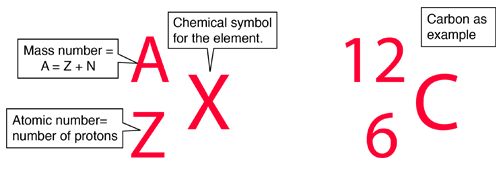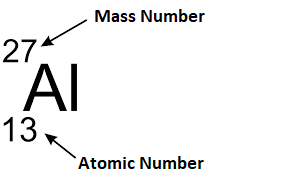Atomic Number & Atomic Mass | Mass NumberAtomic NumberThe total number of protons present in the nucleus of an atom is known as its atomic number. For example, Nitrogen has seven protons, so its atomic number is seven. It is denoted by the letter Z of English. It is a number assigned to a particular element based on the number of protons present in its atoms. All the atoms of an element contain the same number of protons. Besides this, it is a unique number as two different elements cannot have the same number of protons, e.g., for example, oxygen has eight protons and no other element can have eight protons. So, atomic number acts as the identity of an element. Besides this, atomic number defines the characteristics or properties of an element as in a neutral atom, it is equal to the number of electrons, which determine the valency (reactive capacity) of an atom. The reactive capacity decides the properties of elements. So, it is also the characteristic property of an element. Furthermore, the atomic number is always a whole number as the number of protons is fixed in an atom. The number of electrons may change as they take part in chemical reactions where an atom may lose or gain electrons. Atomic MassIt is the mass of a single atom of an element, which includes the total number of protons and neutrons present in the nucleus of an atom. It does not include electrons as their weight is negligible as compared to protons and neutrons that have a significant amount of mass. We can say that electrons do not contribute to the mass number of an atom as their mass is negligible as compared to the mass of a proton or a neutron. So, electrons are considered weightless. Atomic mass is also referred to as the mass number. So, we can say that the sum of all protons and neutrons present in the nucleus of an atom is called its mass number. The protons and neutrons are collectively known as nucleons as they are contained in the nucleus. So, we can say that the atomic mass or mass number is equal to the total number of nucleons present in the atom of an element. How is atomic mass measured?The protons and neutrons that contribute to the atomic mass are present in the nucleus, which is present at the centre of the atom and its size is very small as compared to the atom. So, the mass of atoms is so small that it was difficult for the scientist to measure and represent its mass. For example, the atomic mass of a hydrogen atom is 1.67 x 10-27 kg. This way of representing atomic mass was not easy or appropriate, so to simplify the method or to assign an easy atomic mass figure, the concept of relative atomic mass was introduced by the scientists and a new unit called atomic mass unit (amu) was introduced to calculate the atomic mass of an atom. What is the atomic mass unit (amu)?The atomic mass unit is the unit to measure and represent the atomic mass. It is equal to one-twelfth (1/12) of the mass of a carbon-12 atom. For example, if we divide C 12 atom into 12 equal pieces and take one piece then we can say that mass of this one piece is equal to 1 atomic mass unit, which is used as a standard to calculate the mass of any other atom. So, 1 amu = 1/12th x mass of C-12. There are 12 nucleons (protons + neutrons) in the nucleus of Carbon. So, when we divide it into twelve parts, 1 amu is nearly equal to the 1 proton. As of now amu is simply known as unified atomic mass and is written as 'u'. So, Atomic mass of an element = Mass number of one atom of the element (protons + neutrons) / (1/12) x mass of carbon For example, atomic mass of oxygen in amu = 16 (8 proton + 8 neutron) / 1/12x 12 = 16 amu So, we can say that the atomic mass of an element is the number of times its atom is heavier than 1/12th of the mass of an atom of C-12, e.g., the atomic mass of Mg is 24 u. It means the atomic mass or mass of one atom of Magnesium is 24 times more than the 1/12 of the atomic mass of carbon 12. From the above relation between the mass number and protons and neutrons. We can calculate the number of neutrons if we have the mass number and number of protons of an element. Similarly, the number of protons can be calculated if the mass number and number of neurons are given. For example, Atomic mass of Aluminium = 27 No. of protons are given = 13 So, No. of neutrons = 27 - 13 (atomic mass - number of protons) = 14 Similarly, no of protons = 27 - 14 (atomic mass - number of neutrons) = 13 Similarly, if the atomic number (Z) and atomic mass (A) of an element are given, we can find out number of protons, neutrons and electrons in the given element. For example, The atomic number of Aluminium is 13 and its atomic mass or mass number is 27. In this case,
Difference between Atomic Number and Atomic Mass
How are the Atomic Number and the Mass Number of an element represented?The atomic number of an element is usually denoted by the English letter Z, whereas the atomic mass is represented by the English alphabet 'A'. They are represented along with the symbol of the element as shown in the below image: Z comes at subscript and A is written at superscript to the left-hand side of the symbol of an element. For example, a single atom of carbon has 6 protons and 6 neutrons, so its atomic number is equal to 6 and mass number 12. 
Similarly, a single atom of Aluminium has 13 protons and 14 neutrons, so its atomic number is 13 and mass number is 27 as shown in the below image. 
Next TopicStructure of Atom
|
 For Videos Join Our Youtube Channel: Join Now
For Videos Join Our Youtube Channel: Join Now
Feedback
- Send your Feedback to [email protected]
Help Others, Please Share










